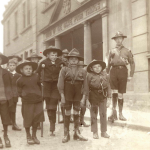Who works in the museum sector and gets to choose the stories that museums and heritage sites tell? A debate which has been simmering for years in museums has now resurfaced more loudly. There are several factors that have meant the keepers of history are not representative of the wider population. For some, a lack of resources to spend months in unpaid interships means that people from less wealthy backgrounds struggle to get the experience for a first job. For others, the demographic you come from still seems to shape your chances of finding work in the sector.
In its last report on the diversity of the cultural sector, Arts Council England found that the number of deaf and disabled people in the sector is actually going backwards: at 4% in 2015 – 16, down by 3.5% compared to the previous year.
One member of our Heritage Hub steering group, Jessica Starns, was among those who could not find paid work in the cultural sector. In this article written for the Heritage Lottery Fund, she describes how she eventually found work at the British Museum after picking up skills on the TOWIE (‘The only way is Ethics’) scheme. She writes:
“The project, run by Emergency Exit Arts, was for young people aged 18-25 and the aim was to give young people the skills to deliver heritage projects. The Bishopsgate Institute was given an archive on the Mondcivitan Republic [a nation without territory, whose citizens across the world worked to promote peace and unity in the aftermath of World War II], and we received training to interpret the archive, and share our discoveries with others.”
As part of TOWIE, Jess helped produce a toolkit about best practices for working with young people on heritage projects: “I really enjoyed the project, especially being involved with people who are a similar age to me – just being creative and making something that we could talk about in finding employment.”









